

Every few months we like to see what conclusions we can draw from the results of the biweekly polls we’ve been running on LinkedIn for over a year1.
In this blog, we consider responses that shed light on how you treat—and are treated by—your customers.
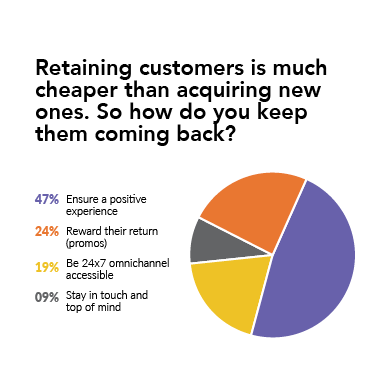
A couple of ways to slice and dice this one. Clearly, every CX leader prioritizes delivering positive customer experiences. About half the respondents selected that one, and we’re confident it would be all the other respondents’ second choice. But given its obvious appeal, why didn’t “ensure a positive experience” get 100 percent of the votes cast? About a quarter of voters apparently believed it was more effective—or maybe just easier—to offer their customers incentives (“bribes” is such a sordid term) than give them a pleasant experience. And one in five took a very tactical stance, saying they’d just keep the communication channels open and responsive all the time; sort of a “build it and they will come [back]” approach. That one strikes us as a necessary but, on its own, insufficient way to hang onto customers. One in ten voters thought simply staying connected would do the trick. Again, an arrow you definitely want in your quiver, but hard to see how you win the battle with it alone.
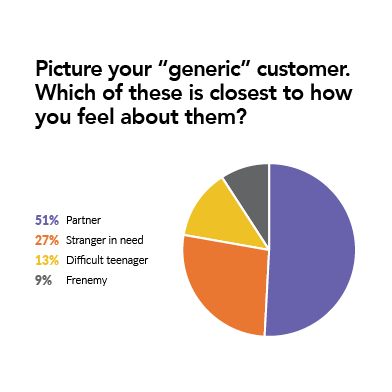
Heartening, understandable but unfortunate, and just plain sad. About half of organizations consider their customers to be partners. That’s the heartening part. Think of it: Partners work together toward a common goal. They’re in synch, not at cross purposes; they understand one another, and both expect to benefit in the relationship. It’s a win-win. The quarter that selected “Stranger in need,” on the other hand, profess not to understand their customers. These respondents’ hearts (and presumably business models) are in the right place: They want to help customers. But for some reason, they don’t know much about who they’re supposed to be helping, which makes their task all the harder. The “sad” judgement is rendered for the one in five respondents who feel antagonistic toward their customers. Not only won’t that work very well practically, but it’s a posture that will drain your lifeforce. Time to get out of customer service.
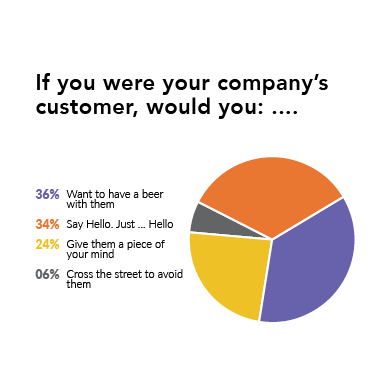
This one is pretty clear. About a third of respondents say their customers feel like they’re part of the family, a third feel their customers could take them or leave them, a quarter feel their brand has done their customers wrong—or that their customers are just knee-jerk complainers—and about one in twenty suspect their customers are mad enough to call the whole thing off. Maybe the two-thirds who aren’t feeling the love are being rational: Obviously, not even the customer-friendliest companies expect every customer to love them. Many people are devoted to particular brands but, despite companies’ best efforts, most people maintain a relationship that’s largely transactional. Which is why between 65 and 85 percent of consumers say they’ve ghosted a brand after just one or two bad experiences. Still, we were hoping more respondents would at least feel their customers could be pals, even if that feeling is misguided.
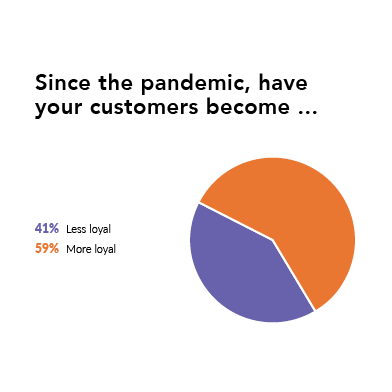
There’s plenty of evidence that customers, not businesses, increasingly hold the relationship’s upper hand—and they know it. So it’s perhaps surprising that a majority of organizations believe the pandemic drove up customer loyalty. We speculate that these are the businesses that came through for their customers in a big way when their customers needed them most, providing service and stability during a deeply uncertain and troubling time. Customer loyalty was likely further forged by an almost “wartime” mentality: “Things are bad but we’re in this together—and we’re getting through this together.”
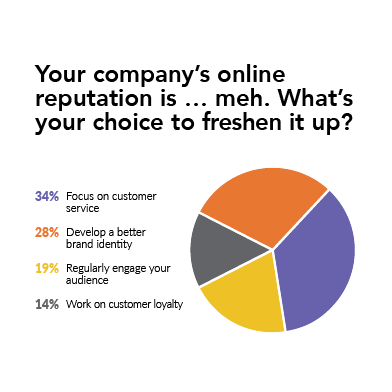
With online sentiment running against them, two-thirds of respondents would double down on their customers by focusing on customer service, regularly engaging with their audience, and doing whatever they can to improve customer loyalty. And in a bold move that could be smart or a sign of total desperation, more than a quarter would turn inward, having decided their best path was to reinvent the brand and hope customers are willing to give them another go.
Read the first blog in the series: What [24]7.ai™ CX Polling Says About … Your CX Operations
If you value customer service, you owe it to your organization to visit the Why [24]7.ai? web page.
Notes: